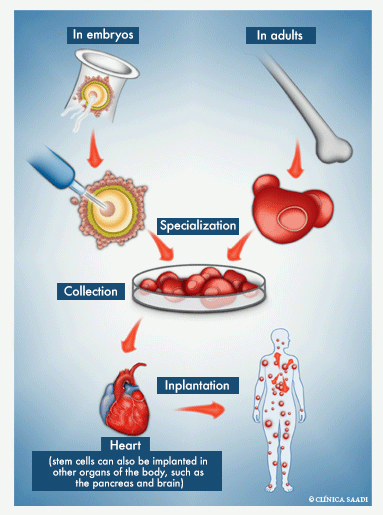Cardiovascular system Stem cells
Stem cells: Every pluricellular organism is composed by different cell types. There are more than 200 different cell types among the 75 trillion cells existing in an adult man. All these cells derive from precursor cells, called as stem cells or mother cells. These are master cells that have the ability of transforming themselves in other differentiated cell types, such as the ones in the heart, brain, bones, and skin. This is a special ability, as the other cells can be only part of a specific tissue (for example, skin cells can only constitute skin). Other special ability of the stem cells is the self-replication: they can generate identical copies of themselves.
Because of these abilities, the stem cells have been the subject of much research and could hypothetically work as substitute cells in injured or dead tissues. Their potential application in the medical science is immense in cardiac diseases (myocardial infarction, chronic ischemic cardiopathy, dilated myocardiopathy, and Chagas’s cardiopathy), besides in other diseases, such as neurological diseases (Alzheimer, Parkinson), neuromuscular diseases, and diabetes, among others.

The process to generate specialized cells (heart, blood, bones, nerves) is controlled by the specific genes in the stem cells, but all factors involved in such differentiation are still not known. Understanding and controlling this process is one of the greatest challenges for the future.
The stem cells are classified as:
A) Totipotent or embryonic: these are the ones that can differentiate in all the tissues that form the human body, including placenta and embryonic annexes. They are only found in embryos with up to 3 to 4 days of life (16 to 32 cells).
B) Pluripotent or multipotent: these can differentiate in almost all body tissues, except for placenta and embryonic annexes. They are present in the first phases, when the embryo has up to 32 to 64 cells (from the fifth day of life).
C) Oligopotent: these can differentiate in few tissues. They are found in the gastrointestinal tract.
D) Unipotent: these can differentiate in a single tissue and are present in the adult brain and the prostate gland.
The stem cells work as wild-card cells in the human body, helping to repair an injury. The stem cells of the bone marrow (adult) have a function of regeneration of blood cells.
Theoretically, the application of these cells in an injured or dead tissue (for example, cardiac muscle) could make them differentiate in myocardial cells, repairing or improving the heart function. This application has been studied by injections directly on the cardiac muscle and by their administration in coronary arteries.
There is evidence saying that, in case of muscular injury, the adult stem cells in the bone marrow can migrate to the injured site and originate skeletal muscle cells. Researchers have recently verified that these cells have multipotent and even pluripotent potential, depending on the environment they are placed at.
The potential use of these adult stem cells in research would eliminate the ethical-religious issues involving the research with embryonic cells. However, it does not seem logical that these adult cells from the bone marrow of the same patient (autologous) might cure diseases, mainly the ones from genetic source. Therefore, it is important that the research proceeds, in order to compare the effectivity of the embryonic stem cells to the one of adult stem cells (from the bone marrow), associated to genetic therapy.
The treatment with stem cells keeps being experimental. Studies will show the real role of this treatment type as the time passes.
Support notes
Ischemic cardiopathy: Term used to define narrowings of the coronary arteries, which take oxygen-rich blood to the heart. Click here to go to the page of Ischemic Cardiopathy and to know more about this subject.

